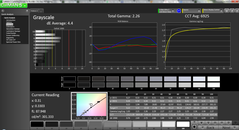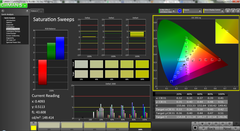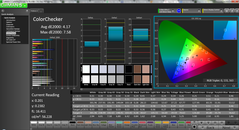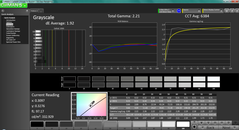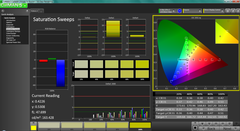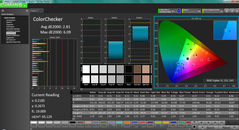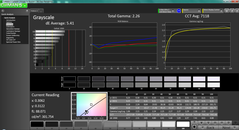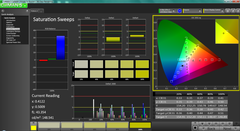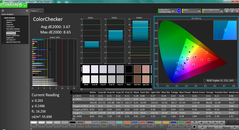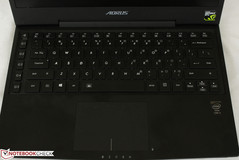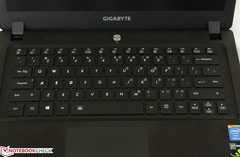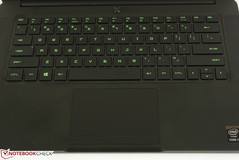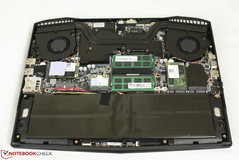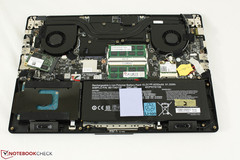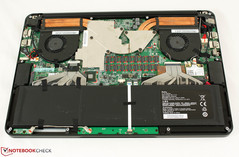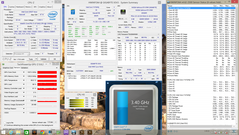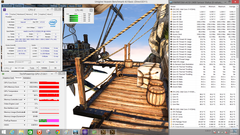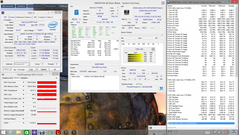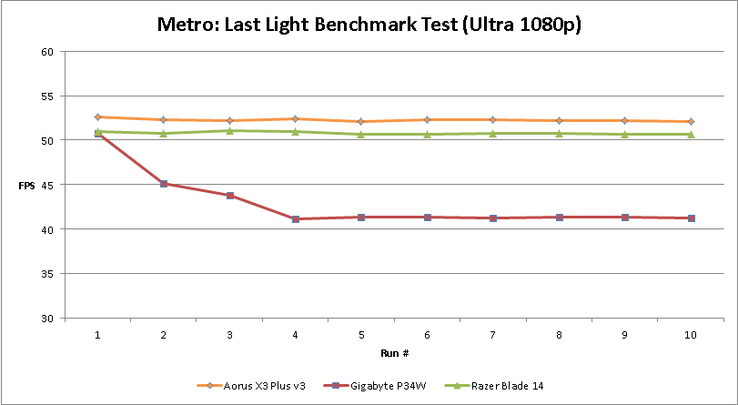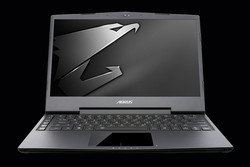Face Off: Aorus X3 Plus vs. Gigabyte P34W vs. Razer Blade 14

Hardcore gaming on notebooks was almost laughable just a few years ago, but advances in hardware and performance-per-watt have genuinely made games playable on small 4K resolution 14-inch screens. Such notebooks are still big investments, however, as they carry powerful hardware paired with expensive starting prices. This Face Off will compare the three smallest and most popular 14-inch ultrathin gaming notebooks available today -- the Razer Blade 14, Aorus X3 Plus v3, and Gigabyte P34W -- to help buyers decide where to best open their wallets.
We encourage users to check out our dedicated review pages for each of the three models for more detailed analyses and data. This comparison is by no means a replacement, but a comparison aid for those on the fence.
Case
Nobody wants a janky $2000 piece of technology. In terms of chassis quality, the Razer Blade 14 takes the cake by far. The more unibody all-aluminum design is sleeker and smoother than both the Aorus and Gigabyte and is more consistent in its rigidity from top to bottom. The Razer even manages to come out a few millimeters thinner, but is slightly wider than the other two. Its overall design was clearly inspired by the minimalistic tone of MacBooks.
The next notebook down in quality is the Gigabyte P34W. It is perhaps the most blandly designed of the three with its use of both matte polycarbonate and aluminum, but is rigid nonetheless with no noticeably weak areas. It stands in between the Blade 14 and X3 Plus in terms of thickness while weighing about the same as the latter.
The Aorus X3 Plus finishes it off at the bottom of the list. Its sharp and slanted appearance stand opposite to the design philosophy of the Blade 14 and fortunately retains an all-aluminum form factor. While the base is strong, its hinges and lid are far more susceptible to twisting and damage than both displays of the Razer and Gigabyte. Quality is comparatively weak in these particular areas with noticeable creaking when attempting to adjust the display.
The better-built notebook here is from Razer by at least a couple of steps ahead and users won't even need to sacrifice size or thickness along the way.
Winner: Razer Blade 14
Connectivity
Connections and expansions are typically more limited on smaller and thinner laptops. Nonetheless, both the Aorus and Gigabyte offer multiple USB 3.0 ports, HDMI, and Gigabit Ethernet with Mini DisplayPort on the former and legacy VGA on the latter. Meanwhile, storage options include 1x mSATA and 1x 2.5-inch SATA III on the P34W and 3x mSATA on the Aorus with RAID 0. Users on a tighter budget may prefer the P34W for its compatibility with inexpensive HDDs while enthusiasts may want to double down on multiple mSATA slots at the expense of a 2.5-inch SATA bay. Thus, it's a tie between the Aorus and Gigabyte with equal pros and cons for both.
The clear loser in this category is the Blade 14 by far. This notebook lacks RJ-45, has only one video-out port, and doesn't even include a built-in card reader. This is the high price users must pay for its thin and minimalistic looks. Furthermore, it only has a single M.2 storage slot with no secondary options. Upgrading the SSD will be very costly and almost necessary as the user's gaming library grows over time.
Winner: Tie -- Aorus X3 Plus v3 and Gigabyte P34W
| Aorus X3 Plus v3 | Gigabyte P34W | Razer Blade 14 | |
| USB | 3x USB 3.0 | 4x USB 3.0 | 3x USB 3.0 |
| Video-out | HDMI, Mini DisplayPort | HDMI, VGA | HDMI |
| Other | SD reader, Gigabit Ethernet, 1x 3.5 mm mic, 1x 3.5 mm headphones | SD reader, Gigabit Ethernet, 1x 3.5 mm combo | 1x 3.5 mm combo |
| Storage Bays | 3x mSATA slots with RAID 0 | 1x mSATA slot, 1x 2.5-inch SATA III bay, no RAID 0 | 1x M.2 slot |
Display
From a purely visual standpoint, the 3200 x 1800 resolution displays of the Aorus X3 Plus and Razer Blade 14 trounce the 1080p display of the Gigabyte. The Razer still comes out on top as its glossy glass panel and touchscreen option provide better rigidity, higher apparent contrast, and modes of usability. Of course, users can argue against the touchscreen novelty and glare disadvantages from such a display for gaming. Color accuracy and gamut between these two models are very good and nearly alike as both use identical display panels from Sharp that can also be found on the Fujitsu LifeBook U904.
The P34W loses this round, though not because it carries a poor display panel. Its AU Optronics display is indeed of high quality in terms of color accuracy, gamut, and brightness that rival its two competitors. Instead, the P34W is at the bottom for offering lower contrast and a 64 percent decrease in pixel count than the dense displays of the Blade 14 and X3 Plus. With no QHD+ options from Gigabyte, the display of the P34W is simply not as sharp.
Winner: Razer Blade 14
| Aorus X3 Plus v3 | Gigabyte P34W | Razer Blade 14 | |
| Size | 13.9-inch IPS | 14-inch IPS | 14-inch IPS |
| Native Resolution | 3200 x 1800 | 1920 x 1080 | 3200 x 1800 |
| Pixel Density | 264 PPI | 157 PPI | 262 PPI |
| Panel ID | Sharp LQ140Z1JW01 | AU Optronics B140HAN01.1 | Sharp LQ140Z1JW01 |
| Panel | Matte | Matte | Glossy |
| Glass Touchscreen | No | No | Yes |
| Aorus X3 Plus v3 | Gigabyte P34W V3 | Razer Blade 14 2015 | |
|---|---|---|---|
| Display | |||
| Display P3 Coverage | 67.6 | 69.4 | 70.3 |
| sRGB Coverage | 93.2 | 92.6 | 97.1 |
| AdobeRGB 1998 Coverage | 69 | 67.4 | 71.1 |
| Screen | |||
| Brightness middle | 312.4 | 305.4 | 318.4 |
| Brightness | 306 | 277 | 311 |
| Brightness Distribution | 91 | 84 | 78 |
| Black Level * | 0.504 | 0.72 | 0.416 |
| Contrast | 620 | 424 | 765 |
| Colorchecker dE 2000 * | 4.17 | 2.81 | 3.67 |
| Greyscale dE 2000 * | 4.4 | 1.92 | 5.41 |
| Gamma | 2.26 97% | 2.21 100% | 2.26 97% |
| CCT | 6925 94% | 6384 102% | 7118 91% |
| Color Space (Percent of AdobeRGB 1998) | 62 | 60.4 | 64.64 |
| Total Average (Program / Settings) |
* ... smaller is better
Input Devices
The keyboards between all three models are identical in size at 28.5 x 10.5 cm excluding the Macro keys on the Aorus. While travel and feedback are also similar between them, the keys of the Aorus have a firmer feel and clatter and are thus ever so slightly more comfortable to use. The addition of Macro keys on the X3 Plus gives it another leg up when gaming. Nonetheless, the Up and Down Arrow keys are still horrendous on all models due to their small sizes and there are no dedicated Volume or Brightness keys to be found.
The touchpads all support multi-touch and are responsive with no random cursor jumps or bugs. The Gigabyte has the smallest touchpad and largest mouse keys, yet the mouse keys themselves provide poor feedback. Meanwhile, the glossy surface of the Aorus touchpad may look nice and reflective, but performs poorly with its irregular glide. The Razer holds the best touchpad as it is both larger than than the Gigabyte with better glide than the Aorus and larger dedicated mouse keys with satisfactory feedback.
Winner: Keyboard -- Aorus X3 Plus v3
Touchpad -- Razer Blade 14
| Aorus X3 Plus v3 | Gigabyte P34W | Razer Blade 14 | |
| Keyboard Size | 28.5 x 6.5 cm | 28.5 x 6.5 cm | 28.5 x 6.5 cm |
| Touchpad Size | 10.0 x 7.0 cm | 10.0 x 5.5 cm | 10.5 x 6.5 cm |
| Touchpad Surface | Smooth matte | Glossy | Smooth matte |
| Dedicated Mouse Buttons | No | Yes | Yes |
| Macro Keys | Yes | No | No |
Performance
CPU Performance
The Blade 14 and P34W share the same Core i7-4720HQ processor while the Aorus X3 Plus v3 uses the slightly slower Core i7-4710HQ. "Slightly" is an exaggeration here as both quad-core processors have the exact same cache sizes and features, but the i7-4710HQ runs just 100 MHz slower in base speed and Turbo Boost. Raw single-thread and multi-thread performances according to Super Pi and wPrime are thus a hair slower on the Aorus, but make essentially no difference in games as modern titles are typically bound by the GPU.
Because of the indistinguishable CPU performances in real-world applications, the three models stand equal in this regard.
| Aorus X3 Plus v3 | Gigabyte P34W | Razer Blade 14 | |
| CPU | 2.5 GHz Core i7-4710HQ | 2.6 GHz Intel Core i7-4720HQ | 2.6 GHz Intel Core i7-4720HQ |
| RAM | 16 GB, 2x SODIMM | 16 GB, 2x SODIMM | 16 GB, non-removable |
| GPU | Nvidia GTX 970M w/ 6 GB GDDR5 VRAM | Nvidia GTX 970M w/ 3 GB GDDR5 VRAM | Nvidia GTX 970M w/ 3 GB GDDR5 VRAM |
| GPU Driver | 344.42 | 344.75 | 344.77 |
| Cinebench R15 | |
| CPU Single 64Bit (sort by value) | |
| Aorus X3 Plus v3 | |
| Gigabyte P34W V3 | |
| Razer Blade 14 2015 | |
| CPU Multi 64Bit (sort by value) | |
| Aorus X3 Plus v3 | |
| Gigabyte P34W V3 | |
| Razer Blade 14 2015 | |
| Cinebench R11.5 | |
| CPU Single 64Bit (sort by value) | |
| Aorus X3 Plus v3 | |
| Gigabyte P34W V3 | |
| Razer Blade 14 2015 | |
| CPU Multi 64Bit (sort by value) | |
| Aorus X3 Plus v3 | |
| Gigabyte P34W V3 | |
| Razer Blade 14 2015 | |
| Cinebench R10 | |
| Rendering Single CPUs 64Bit (sort by value) | |
| Aorus X3 Plus v3 | |
| Gigabyte P34W V3 | |
| Razer Blade 14 2015 | |
| Rendering Multiple CPUs 64Bit (sort by value) | |
| Aorus X3 Plus v3 | |
| Gigabyte P34W V3 | |
| Razer Blade 14 2015 | |
| wPrime 2.10 | |
| 1024m (sort by value) | |
| Aorus X3 Plus v3 | |
| Gigabyte P34W V3 | |
| Razer Blade 14 2015 | |
| 32m (sort by value) | |
| Aorus X3 Plus v3 | |
| Gigabyte P34W V3 | |
| Razer Blade 14 2015 | |
| Super Pi Mod 1.5 XS 32M - 32M (sort by value) | |
| Aorus X3 Plus v3 | |
| Gigabyte P34W V3 | |
| Razer Blade 14 2015 | |
| 3DMark | |
| 1280x720 offscreen Ice Storm Unlimited Physics (sort by value) | |
| Aorus X3 Plus v3 | |
| Gigabyte P34W V3 | |
| Razer Blade 14 2015 | |
| 1920x1080 Ice Storm Extreme Physics (sort by value) | |
| Aorus X3 Plus v3 | |
| Gigabyte P34W V3 | |
| Razer Blade 14 2015 | |
| 1280x720 Cloud Gate Standard Physics (sort by value) | |
| Aorus X3 Plus v3 | |
| Gigabyte P34W V3 | |
| Razer Blade 14 2015 | |
| 1920x1080 Fire Strike Physics (sort by value) | |
| Aorus X3 Plus v3 | |
| Gigabyte P34W V3 | |
| Razer Blade 14 2015 | |
| Fire Strike Extreme Physics (sort by value) | |
| Aorus X3 Plus v3 | |
| Gigabyte P34W V3 | |
| Razer Blade 14 2015 | |
* ... smaller is better
GPU Performance
Graphics performance is the deal breaker for any gaming notebook. The three competitors share nearly identical scores in both synthetic and in-game benchmarks. The exception is the Blade 14, which curiously returns unreasonably low 3DMark and CineBench scores despite our attempts at re-running the benchmarks. Thankfully, its gaming performance is not at all affected. It's a three-way tie based on these hard numbers.
| 3DMark | |
| 1280x720 offscreen Ice Storm Unlimited Graphics Score (sort by value) | |
| Aorus X3 Plus v3 | |
| Gigabyte P34W V3 | |
| Razer Blade 14 2015 | |
| 1920x1080 Ice Storm Extreme Graphics (sort by value) | |
| Aorus X3 Plus v3 | |
| Gigabyte P34W V3 | |
| Razer Blade 14 2015 | |
| 1280x720 Cloud Gate Standard Graphics (sort by value) | |
| Aorus X3 Plus v3 | |
| Gigabyte P34W V3 | |
| Razer Blade 14 2015 | |
| 1920x1080 Fire Strike Graphics (sort by value) | |
| Aorus X3 Plus v3 | |
| Gigabyte P34W V3 | |
| Razer Blade 14 2015 | |
| Fire Strike Extreme Graphics (sort by value) | |
| Aorus X3 Plus v3 | |
| Gigabyte P34W V3 | |
| Razer Blade 14 2015 | |
| 3DMark 11 - 1280x720 Performance GPU (sort by value) | |
| Aorus X3 Plus v3 | |
| Gigabyte P34W V3 | |
| Razer Blade 14 2015 | |
| Cinebench R11.5 - OpenGL 64Bit (sort by value) | |
| Aorus X3 Plus v3 | |
| Gigabyte P34W V3 | |
| Razer Blade 14 2015 | |
| Cinebench R15 - OpenGL 64Bit (sort by value) | |
| Aorus X3 Plus v3 | |
| Gigabyte P34W V3 | |
| Razer Blade 14 2015 | |
| Sleeping Dogs | |
| 1366x768 High Preset AA:High (sort by value) | |
| Aorus X3 Plus v3 | |
| Gigabyte P34W V3 | |
| Razer Blade 14 2015 | |
| 1920x1080 Extreme Preset AA:Extreme (sort by value) | |
| Aorus X3 Plus v3 | |
| Gigabyte P34W V3 | |
| Razer Blade 14 2015 | |
| Guild Wars 2 | |
| 1366x768 Best Appearance Preset AA:FX (sort by value) | |
| Aorus X3 Plus v3 | |
| Gigabyte P34W V3 | |
| Razer Blade 14 2015 | |
| 1920x1080 All Maximum / On AA:FX (sort by value) | |
| Aorus X3 Plus v3 | |
| Gigabyte P34W V3 | |
| Razer Blade 14 2015 | |
| Tomb Raider | |
| 1366x768 High Preset AA:FX AF:8x (sort by value) | |
| Aorus X3 Plus v3 | |
| Gigabyte P34W V3 | |
| Razer Blade 14 2015 | |
| 1920x1080 Ultra Preset AA:FX AF:16x (sort by value) | |
| Aorus X3 Plus v3 | |
| Gigabyte P34W V3 | |
| Razer Blade 14 2015 | |
| StarCraft II: Heart of the Swarm | |
| 1366x768 High AA:on (sort by value) | |
| Aorus X3 Plus v3 | |
| Gigabyte P34W V3 | |
| Razer Blade 14 2015 | |
| 1920x1080 Ultra / Extreme AA:on (sort by value) | |
| Aorus X3 Plus v3 | |
| Gigabyte P34W V3 | |
| Razer Blade 14 2015 | |
| BioShock Infinite | |
| 1366x768 High Preset (sort by value) | |
| Aorus X3 Plus v3 | |
| Gigabyte P34W V3 | |
| Razer Blade 14 2015 | |
| 1920x1080 Ultra Preset, DX11 (DDOF) (sort by value) | |
| Aorus X3 Plus v3 | |
| Gigabyte P34W V3 | |
| Razer Blade 14 2015 | |
| Metro: Last Light | |
| 1366x768 High (DX11) AF:16x (sort by value) | |
| Aorus X3 Plus v3 | |
| Gigabyte P34W V3 | |
| Razer Blade 14 2015 | |
| 1920x1080 Very High (DX11) AF:16x (sort by value) | |
| Aorus X3 Plus v3 | |
| Gigabyte P34W V3 | |
| Razer Blade 14 2015 | |
| Thief | |
| 1366x768 High Preset AA:FXAA & Low SS AF:4x (sort by value) | |
| Aorus X3 Plus v3 | |
| Gigabyte P34W V3 | |
| Razer Blade 14 2015 | |
| 1920x1080 Very High Preset AA:FXAA & High SS AF:8x (sort by value) | |
| Aorus X3 Plus v3 | |
| Gigabyte P34W V3 | |
| Razer Blade 14 2015 | |
| Middle-earth: Shadow of Mordor | |
| 1920x1080 High Preset (sort by value) | |
| Aorus X3 Plus v3 | |
| Gigabyte P34W V3 | |
| Razer Blade 14 2015 | |
| 1920x1080 Ultra Preset (HD Package) (sort by value) | |
| Aorus X3 Plus v3 | |
| Gigabyte P34W V3 | |
| Razer Blade 14 2015 | |
| Ryse: Son of Rome | |
| 1920x1080 High Texture Res. + High Graphics Quality (Rest Off/Disabled) AF:8x (sort by value) | |
| Aorus X3 Plus v3 | |
| Gigabyte P34W V3 | |
| Razer Blade 14 2015 | |
| 1920x1080 Very High Texture Res. + High Graphics Quality (Motion Blur & Temporal AA On, Rest Off/Disabled) AF:8x (sort by value) | |
| Aorus X3 Plus v3 | |
| Gigabyte P34W V3 | |
| Razer Blade 14 2015 | |
| F1 2014 | |
| 1920x1080 High Preset (sort by value) | |
| Aorus X3 Plus v3 | |
| Gigabyte P34W V3 | |
| Razer Blade 14 2015 | |
| 1920x1080 Ultra Preset AA:4x MS (sort by value) | |
| Aorus X3 Plus v3 | |
| Gigabyte P34W V3 | |
| Razer Blade 14 2015 | |
QHD+ Performance
Gaming on native 3200 x 1800 resolution is very possible on both the Aorus and Razer Blade models. In almost every tested case, the Aorus comes out just slightly ahead of the Razer. This is in part due to the additional 3 GB VRAM on the Aorus as memory overhead plays a more significant role on higher resolutions. In either case, most games will need to have other graphical effects turned down to obtain more playable frame rates as demonstrated by our Ultra results below.
| Aorus X3 Plus v3 | Razer Blade 14 | |
| Sleeping Dogs | 14.9 | 13.8 |
| Guild Wars 2 | 40.3 | 38.8 |
| Tomb Raider | 32.1 | 32.5 |
| Starcraft II: Heart of the Swarm | 50.1 | 45.6 |
| Metro: Last Light | 23.9 | 23.6 |
| Thief | 21.8 | 21.4 |
| Middle-earth: Shadow of Mordor | 26 | 23.7 |
| Ryse: Son of Rome | 19.7 | 21.2 |
| F1 2014 | 82 | 66 |
Stress Test
The Unigine Heaven stress test separates the men from the boys so to speak as it is a good indication of just how well gaming systems can perform after extended gaming sessions. The best performer is the Aorus with its overall lower core temperatures and is consequently less likely to throttle when gaming. The Razer performs just as well, but both the CPU and GPU run much warmer and a little bit too close to the alarming 90 C threshold than we would like. The Gigabyte is the unfortunate loser in this round as GPU clock steadily drops over time due to thermal limits.
As an additional test, we ran the Metro: Last Light built-in benchmark ten times in a row on 1080p Ultra settings to compare frame rates between each run. The P34W starts out strong, but falls to its knees after the third or fourth run. Meanwhile, the Aorus and Razer return much more steady results throughout the test.
Winner: Aorus X3 Plus v3
| Aorus X3 Plus v3 | Gigabyte P34W | Razer Blade 14 | |
| GPU Core Clock (MHz) | 1037.4 | <860 | 1037.8 |
| GPU Temperature | 69 C | 85 C | 83 C |
| CPU Temperature | 70 - 75 C | 85 - 88 C | 80 - 85 C |
Emissions
System Noise & Temperature
There is no doubt that all three systems will be loud under stress. But, which is the least loudest?
All models in question are capable of running almost completely silently when idling or on Power Saver. The Aorus and Gigabyte in particular have better fan controls than the Razer as users have the option between Stealth, Max, and two Auto modes. Under gaming conditions, however, the Razer is by far the loudest at the 55 to 60 dB(A) range. The Aorus lies in the center at the 45 to 55 dB(A) range, but it pulsates much more frequently than the other two. Lastly, the Gigabyte is the quietest at the 44 to 49 dB(A) range.
Note that the Aorus and Gigabyte can reach 60 dB(A) when the Max Fan mode is active. Otherwise, fan noise is limited to the low to mid 50s range for both.
The temperature profiles are not dissimilar between the three models due to the similar cooling solutions underneath. The Razer runs warmest overall on both sides of the notebook with the warmest palm rests followed by the Aorus and finally the Gigabyte.
Winner: Gigabyte P34W
| Aorus X3 Plus v3 | Gigabyte P34W | Razer Blade 14 | |
| Fan Noise | 45 - 55 dB(A) | 44 - 49 dB(A) | 50 - 59 dB(A) |
| Temperature | 37.1 C | 35.5 C | 39.7 C |
Battery Life
While the Aorus and Razer have similar Li-Ion battery capacities, the Gigabyte uses a smaller module in order to make room for its 2.5-inch SATA bay. Nonetheless, runtimes when gaming are not significantly different between the three models with no outright winner. Perhaps more notably, the Blade 14 falls a bit flat at about 30 minutes less than the Aorus when under similar testing conditions. We'll give the small edge to the P34W for its longer idling time for potentially longer battery life when running low intensity tasks like word processing.
Winner: Gigabyte P34W
| Aorus X3 Plus v3 73 Wh | Gigabyte P34W V3 61 Wh | Razer Blade 14 2015 71 Wh | |
|---|---|---|---|
| Battery Runtime | |||
| Reader / Idle | 423 | 522 | 380 |
| WiFi v1.3 | 258 | 222 | |
| Load | 96 | 82 | 66 |
| WiFi | 284 |
Verdict
At the time of writing, the Aorus X3 Plus v3, Gigabyte P34W, and Razer Blade 14 are available for $2500, $1600, and $2400, respectively. Lower prices can be found with varying SSD and HDD options.
Unfortunately, no single model is the clear and indisputable winner. Users searching for the best performer will want to go with the Aorus and its 6 GB GTX 970M for better QHD+ gaming and avoid the Gigabyte due to its throttling issues. The major drawbacks will be the weak lid and hinges and slightly thicker build of the X3 Plus.
The super-thin Razer Blade 14 offers the best design and chassis quality with strong performance and no throttling issues. However, users will be stuck with no secondary storage, no upgradeable RAM, limited connectivity ports, higher surface temperatures, and louder fan noise.
Finally, the Gigabyte P34W is best for users on a budget with its cost-effective 2.5-inch SATA bay, great 1080p IPS panel, and lowest fan noise and surface temperatures. Its moderate throttling when gaming is unfortunately a huge drawback as users will not be able to get the full benefits of what the GTX 970M is capable of.
Performance hunters can't go wrong with the X3 Plus v3 or Blade 14. However, we will have to give the edge to the Aorus mainly for its better QHD+ performance and additional connectivity options that should provide longer legs than the Razer. Just watch out for that creaky display.
| Aorus X3 Plus v3 | Gigabyte P34W | Razer Blade 14 | |
Positive |
+ High quality 3200 x 1800 matte IPS panel + Strong all-aluminum base + Sharp, gamer-centric design + HDMI and Mini DisplayPort + Dedicated Macro keys + Great tactile keyboard + Upgradeable SODIMM RAM + 3x mSATA with RAID 0 + Strong GPU performance + 6 GB VRAM for improved QHD+ performance + Fan control options |
+ High quality 1080p matte IPS panel +Lowest fan noise and average surface temperature + HDMI and VGA + Upgradeable SODIMM RAM + 2.5-inch SATA III expansion + Good battery runtimes + Fan control options |
+ High quality 3200 x 1800 glossy IPS touchscreen + Highest apparent contrast + Strong all-aluminum base and lid + Minimalistic design + Strong GPU performance + Very thin, sleek, and portable + Most comfortable touchpad of the three models |
Negative |
- Lid is weak and can creak - Hinges could be more taut - No 2.5-inch SATA expansion - Thickest of the three models - Fans pulsate more frequently - Slightly smaller 13.9-inch screen |
- GPU throttles when gaming - Boring chassis design - No dedicated Macro keys - No QHD+ options - Smallest battery capacity |
- Very few connectivity options - Glossy display - RAM not upgradeable - No secondary storage options - Runs warmest and loudest of the three - No dedicated Macro keys - Slightly lower battery runtimes - Slightly behind in QHD+ gaming performance - Only one video-out port |


 Deutsch
Deutsch English
English Español
Español Français
Français Italiano
Italiano Nederlands
Nederlands Polski
Polski Português
Português Русский
Русский Türkçe
Türkçe Svenska
Svenska Chinese
Chinese Magyar
Magyar